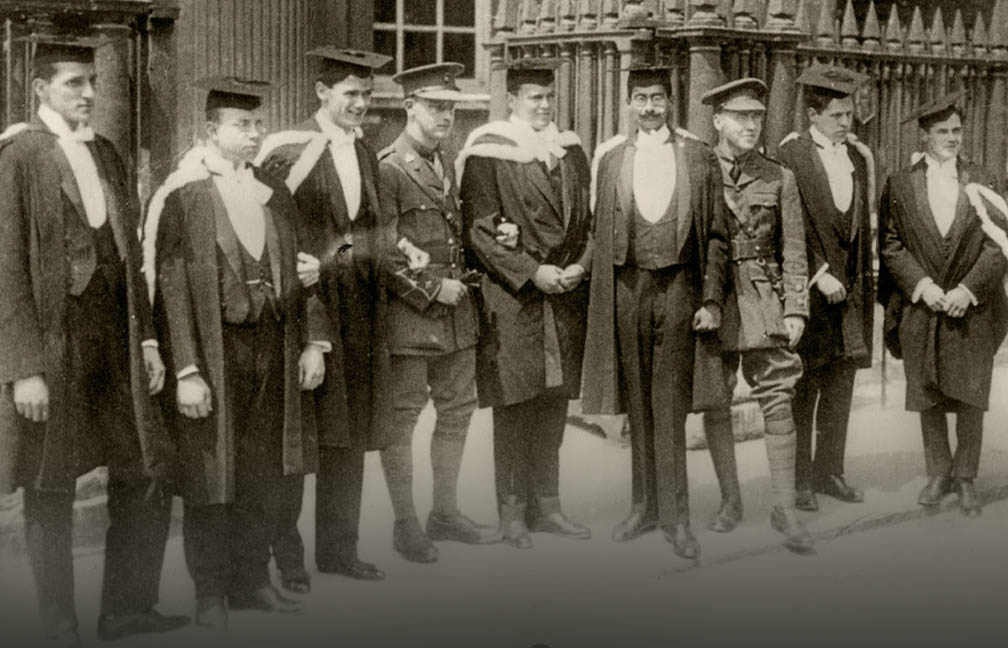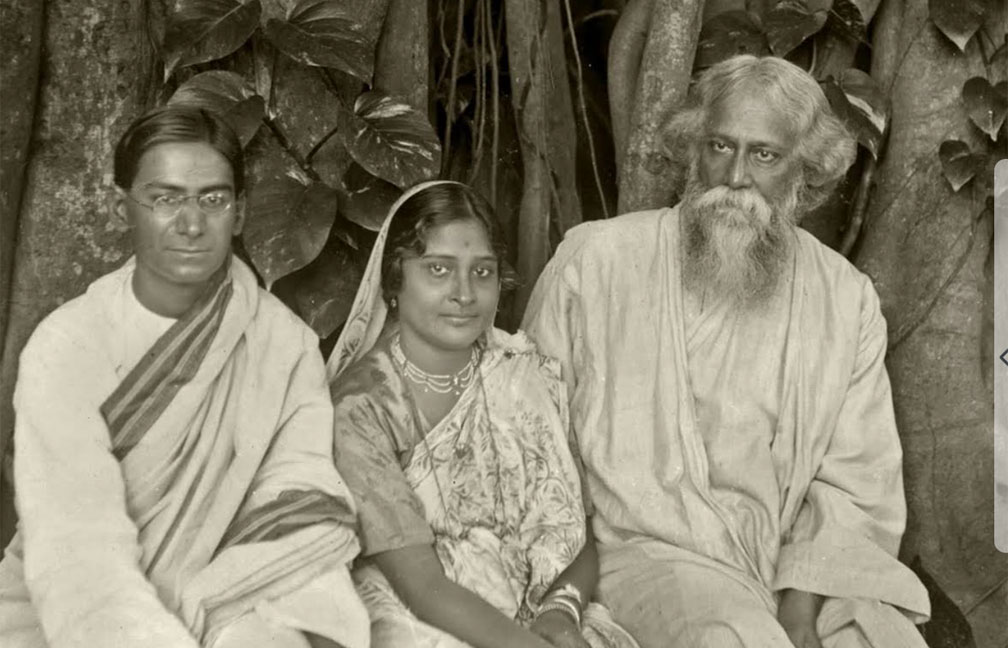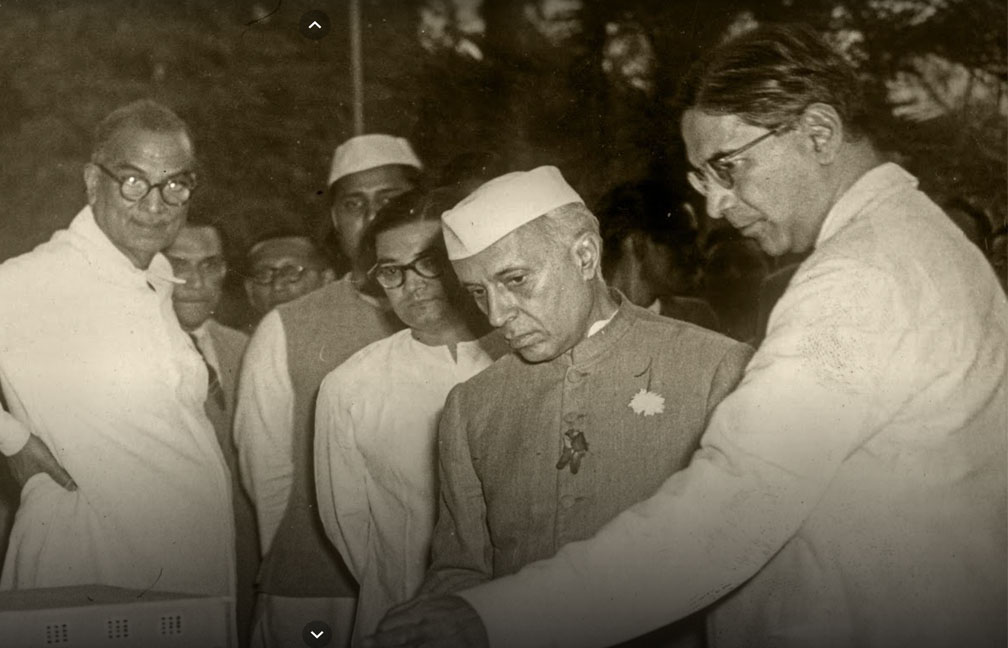Prasanta Chandra Mahalanobis
Prof. Prasanta Chandra Mahalanobis is also known as the father of Indian Statistics. He was a physicist by training, a statistician by instinct and a planner by conviction. His contributions were massive on the academic side as the builder of the Indian Statistical Institute, organizer of the Indian statistical systems, pioneer in the applications of statistical techniques to practical problems, architect of the Indian Second Five Year Plan, and much more. Statistical science was a virgin field and practically unknown in India before the twenties.
Prof. Prasanta Chandra Mahalanobis perceived statistics ‘as a universal tool of inductive inference, research in natural and social sciences, and technological applications’ and ‘as a key technology for increasing the efficiency of human efforts in the widest sense’.
Family
He was born on 29th June 1893 at 210 Cornwallis Street (his grandfather’s house) as the elder son among two sons and four daughters of Probodh Chandra Mahalanobis and Nirodbasini Devi.
Prof. Prasanta Chandra Mahalanobis' actual surname was “Bandyopadhaya”. Possibly six generations before, Guru Charan Mahalanobis started using the surname Mahalanobis as he was appointed to keep the accounts of land and land revenue of Mahal of ancient Bengal. They knew him as “Nauvice”. In Persian “nauvice” means scribe of Mahal (A Mughual administrative unit), so his surname “Mahalanobis” came from the concept of “Mahal” and “Nauvice”. Prasanta Chandra Mahalanobis’s roots were in Panchasar village, now in Vikrampur, Bangladesh. Prasanta Chandra Mahalanobis's grandfather was Guru Charan Mahalanobis who was follower of Sadharan Brahmo Samaj.
Prof. Prasanta Chandra Mahalanobis married Nirmal Kumari (nicknamed Rani), who was the daughter of Puritan Brahmo leader and educationist of Bengal Heramba Chandra Moitra. Nirmal Kumari was the person who stood by the Prof. Prasanta Chandra Mahalanobis in all his struggles, helped him in all his endeavours and exercised a great influence on his life. She often accompanied Prof. Prasanta Chandra Mahalanobis on his frequent tours abroad. Their companionship lasted for 49 years until the death of Mahalanobis.

Prof. Mahalanobis with his wife Nirmal Kumari
Education
He started his education at Brahmo Boys’ School, which was founded by his grandfather Guru Charan Mahalanobis in 1904.
Prof. Prasanta Chandra Mahalanobis earned a Bachelor degree in Science with Honours in Physics from the Calcutta University under Presidency College in 1912, before he sailed to England and joined Cambridge University.
He obtained Mathematics Tripos part I in 1914, and Physics Tripos part II in 1915 from Cambridge University.
As a student, Prof. Prasanta Chandra Mahalanobis never confined himself in his subject books. He was very interested in various subjects like amateur astronomy, philosophy, architecture, and psychology. Around this time, Prasanta Chandra Mahalanobis met with pioneer of Mathematics Srinivasa Ramanujan in Cambridge. He had his initiation in Statistics in 1915 through Biometrika, the journal founded by Karl Pearson.

Standing from right- H.O.William, W.I. Saxton, unidentified person, Prasanta Chandra Mahalanobis, F.B. Johnston, G.A.Lupton, A.W.Neal, E. H. Toulmin, and E.A.Cameau; Degree day, Kings College, Cambridge, 1915
Career
He first joined Presidency College in 1915 as a temporary Professor. In 1922 he became Asst. Professor of Physics and taught Physics for 33 years (1915-1948). He was also the Principal of Presidency College for a few years and held the post of Meteorologist in the Alipore Observatory in Calcutta from 1922 to 1926.
Influence of great minds
Rabindranath Tagore, Prof. Prasanta Chandra Mahalanobis, and Nirmal Kumari Mhahalanobis shared a unique relationship. Rabindranath Tagore used to take a keen interest in Prof. Prasanta Chandra Mahalanobis’s statistical work from the very beginning. Even his career in statistics was very largely influenced by the poet. When Prof. Prasanta Chandra Mahalanobis expressed his interest to work on Statistics, he approached Rabindranath Tagore for his kind opinion. Tagore sent him to meet with Dr. Brajendranath Seal (B.N.Seal). He was further encouraged to engage in statistical research by B. N. Seal who asked him to take up a certain statistical exercise with respect to the examination result of Calcutta University.
Establishment of Indian Statistical Institute
At the time Prof. Prasanta Chandra Mahalanobis was a Professor of Physics at Presidency College, he was highly involved in the work of statistics. He set up the Statistical laboratory in the baker laboratory of Presidency College, Calcutta, in the early 1920s. In the initial phase, his statistical research was in anthropometry, in meteorology and in problems of flood control in North Bengal and Orissa.

Prof. Mahalanobis with Prof. Peake and others at Presidency College, Calcutta
On 17th December, 1931, Prof. Prasanta Chandra Mahalanobis set up the Indian Statistical Institute for advanced research and training in statistics. Later during the 1950s, ISI shifted to the present premises at Baranagar, a suburb of Kolkata, West Bengal.
In 1932, the Institute was located in a small portion of the Physics Department of the Presidency College but by 1972 the Institute had several large building of its own to provide working space for research and training in diverse subjects such as: anthropometry, biochemistry, botany, computer science, crop science, economics, human genetics, precensus, psychometry, sociology, and statistics. The Institute's activities were not confined within Calcutta but spread all over the India.
While Prof. Prasanta Chandra Mahalanobis struggled against many odds in his bid to develop statistics as a science in India, he was lucky to receive whole hearted cooperation and help from a number of people. He had a special ability for locating talents.
From the very beginning of the Institute he was assisted by a number of young and talented researchers, namely Harish Chandra Sinha, Raj Chandra Bose, Samarendra Nath Roy, and Keshvan Raghavan Nair. In 1941 came Calyampudi Radhakrishna Rao. That Mahalanobis was not wrong in his selection of comrades-in-arms was evident from the fact that many of his early associates earned international fame for themselves and the Institute for their outstanding contributions to statistics.
Indian Statistical Institute started courses of study leading to the degrees of Bachelor of Statistics and Master of Statistics from July, 1960 and also made arrangement for the award of Degrees Ph.D. and D.Sc. in Statistics.
The First Convocation of the Indian Statistical Institute was held in the mango-grove of the Institute on 12 February 1962.
The event of first convocation was marked with the conferment of Honorary Doctor of Science to five eminent people: Professor Satyendra Nath Bose, Sir Ronald Aylmer Fisher, Sri Jawaharlal Nehru, Academician Andrey Nikolaevich Kolmogorov and Dr. Walter Andrew Shewhart.
During the first convocation, the Degree of Doctor of Philosophy was conferred to two students, Kalyanapuram Ranga Parthasarathy and Jayaram Sethuraman, and Master of Statistics Degree to Narasimha Sreenivasa Iyengar, Vasant Tukaram Korde, Tares Maitra, Manjula Mukhopadhyay, Ganesan Parthasarathy, Kadiyala Koteswara Rao, and Paras Nath Singh.
Contribution to the field of Statistics
The anthropometric studies led to the formulation of D2- Statistic, known in statistical literature as Mahalanobis Distance, which has proved to be a valuable tool not only in taxonomy but in many other fields including economics and geology. A rich field of research in multivariate analysis opened up; Sir Ronald Aylmer Fisher (R.A.Fisher) accepted this concept by giving it the name ‘Mahalanobis D-square’ or ‘Mahalanobis distance’,
Prof. Prasanta Chandra Mahalanobis was again called upon to tackle the problem of flooding after two devastating floods, one in North Bengal in 1922 and the other in Orissa in 1926. This led him to undertake extensive statistical studies of rainfall and floods in Bengal and Orissa covering a span of about sixty years. The studies yielded some of the basic calculations that were later used for the two hydro-electric and irrigation projects in Hirakud and Damodar Valley.

Prof. Mahalanobis and his wife Nirmal Kumari with Rabindranath Tagore,1925
Prof. Prasanta Chandra Mahalanobis’ first systematic work was on a statistical study of the anthropometric measurements of Anglo-Indians in Calcutta and his first paper was on “Anthropological Observations on the Anglo-Indian of Calcutta Part-I Analysis of Male Stature’urt”, which was published in the records of the Indian Museum in 1922.
Sankhya, The Indian Journal of Statistics, founded by Prof. Prasanta Chandra Mahalanobis in 1933 is the official publication of Indian Statistical Institute. Prof. Prasanta Chandra Mahalanobis explained his reasons for choosing the name Sankhya. In his words: "We believe that the idea underlying this integral concept of statistics finds adequate expression in the ancient Indian word Sankhya. In Sanskrit the usual meaning is ‘number’, but the original root meaning was ‘determinate knowledge"
He was the editor of Sankhya from 1933 to 1972.
Large scale sample surveys
Then came the epoch-making investigation on the technique of large scale sample surveys, with which Prof. Prasanta Chandra Mahalanobis’ name will always be associated. Systematic work on the surveying of agriculture crops began in 1937, which culminated in a large scale sample survey of the acreage and yield of jute crop in 1941. It covered the whole province of Bengal and was extended to all important crops in both Bengal and Bihar in 1943.
This was followed by sample surveys for collecting socio-economic data, such as public preference. A large number of surveys were conducted from 1937-1950 in Bengal for collecting information on crops and socio-economic data, which gave opportunities for improving the design of sample surveys and for gaining experience in the collection of data from the field.
During the sample census on jute crop in Bengal, Prof. Prasanta Chandra Mahalanobis insisted on the use of sampling methodology. But the Government officials had no idea about sampling and the survey was on the verge of being abandoned altogether.
At this juncture, R. A. Fisher came to India in 1938 and in a memorandum submitted to the Viceroy, he strongly recommended the use of sampling methodology in India. At last a large scale sample survey of the area under jute for the whole province of Bengal was undertaken in 1940.
Several hurdles had to be crossed in convincing the administrators that gaps in national income statistics could be filled through data obtained by sampling, and that there would be a need for continuous collection of information to assess the progress of economic development and to make policy decisions.
Prof. Prasanta Chandra Mahalanobis won the battle and the National Sample Survey was established in 1950. It is a continuing survey in which information is collected year by year with the help of a whole time field organization, spread all over India, and which provides periodic estimates on social and economic factors affecting the nation economy.

Prof. Mahalanobis with Prime Minister Jawaharlal Nehru
Establishment of CSO
A Central Statistical Unit was established by the Government of India in 1949 to work under the technical guidance of Prof.Prasanta Chandra Mahalanobis as Honorary Statistical Adviser to the cabinet. For more than two years this unit was entirely staffed from and run by ISI. After two years the Central Statistical Organizations was formed for coordinating all statistical activities of the Government.
Application of Statistical Quality Control
After meeting with Dr. Walter Shewart, who was known as the 'Father of Statistical Quality Control', Prof. Prasanta Chandra Mahalanobis wrote to the Government of India in 1942 pointing out the advantages of using statistical quality control methods, particularly in the industries. As a consequence, the Indian Statistical Institute took initiative in spreading the use of quality control methods in industry by establishing Statistical Quality Control units in different parts of India since 1953.
Even when Prof. Prasanta Chandra Mahalanobis was working on his planning models, he had not stopped giving new ideas in statistical methodology. In 1958 he found a simple but very effective technique known as Fractile Graphical Analysis.
Start of a new era: introduction of computers
Prof. Prasanta Chandra Mahalnobis was one of the first people in the country to recognize the importance of machines – mechanical, electrical as well as electronic – to make fast, accurate and complicated calculations with masses of figures. In the 1950s, Prof. Prasanta Chandra Mahalanobis arranged to have a large number of electromechanical data processing machines from IBM; the Hollerith and the Power Samas varieties were installed to process NSS data. Through his initiative in 1953, a small analog computer was designed and built in the Institute.
Contribution to national development
Prof. Prasanta Chandra Mahalanobis played an important role in Indian National Economic Planning. He took major responsibility in drafting the Second Five Year Plan for India. He believed in perspective planning and used simple logical ideas in deriving an economic model for planning in a under developed country, like India.
As a member of the Planning Commission, he sold the idea of making large investments in heavy industries, setting aside other sectors of development, a policy which helped the country considerably in rapid industrialization.
Prof. Prasanta Chandra Mahalanobis started going abroad from 1946 in connection with the work at the United Nations Statistical Commission in various capacities: as member; Vice-Chairman and Chairman; as its representative on the Population Commission in 1948; and as a member of drafting committee at the Regional Meeting of Statisticians.
Prof. Prasanta Chandra Mahalanobis chaired the Conference of Statisticians of the United Nations Economic Commission for Asia and the Far East, ECAFE (now Economic and Statistical Commission for Asia and Pacific, ESCAP) in 1952.
Awards and accolades
Prof. Prasanta Chandra Mahalanobis received a number of awards and honors in India and abroad for his outstanding and fundamental contribution to Statistics and Planning.
He was elected as fellow of the:
- Royal Society of London in 1945,
- Chairman of the United Nations Sub- Commission on Statistical Sampling (five sessions- 1947-1951)
- Fellow of International Econometric Society (1951)
- Chairman of United Nations Statistical Commission (1954-1958)
- President of National Institute of Sciences of India (1957 and 1958)
- Fellow of American Statistical Association (1961)
- Fellow of World Academy of Art and Science (1963).
Prof. Prasanta Chandra Mahalaonbis was honored with several awards:
-The Weldon Medal from Oxford University (1944),
- Sir Devaprasad Sarbadhikari Gold Medal from Calcutta University (1957),
- Gold Medal from Czechoslovak Academy of Sciences (1964),
- Durga Prasad Khaitan Memorial Gold Medal from Asiatic Society (1968),
- Srinivasa Ramanujam Gold Medal (1968),
- Honorary Deshikottama from Visva Bharati University (1961).
In 1968, he was awarded the Padma Vibhushan, the second highest civilian award by the Republic of India for his contribution to science and services to the country.
He also received honorary doctorates from Calcutta University (1957), Sofi University (1961), Delhi University (1964) and Stockholm University (1966).
Prof. Prasanta Chandra Mahalanobis viewed statistics not as a branch of mathematics but as a technology. Mathematics and probability theory are only the means to promote the use of statistical methods in the world of reality. He shaped Indian Statistical Institute as a beacon of knowledge with commitment for national development and social welfare. He is still being remembered for the Mahalanobis Distance, a statistical measure, and for his great contribution in the large scale sample survey. He continues to inspire statisticians in India and around the world.
Archival video of P.C.Mahalanobis's visit to an Indian village for a sample survey.
